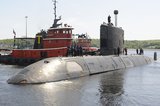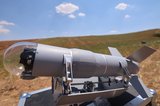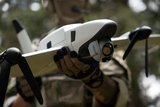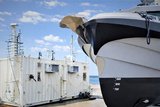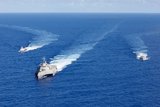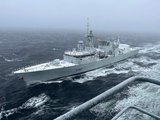Northrop Grumman's CLIP ready for fielding
Northrop Grumman has announced that its Common Link Integration Processing (CLIP) system being developed for the US Air Force (USAF) has received Milestone C acquisition approval, paving the way for the fielding of this software package and providing aircrews with enhanced capabilities to communicate critical tactical information.
CLIP software, designed for a USAF programme that also includes US Navy (USN) platforms, translates and formats messages and allows existing platforms without a tactical data link, as well as platforms with different data links, to communicate with each other.
Northrop Grumman is integrating CLIP in B-52 aircraft and the USN MQ-4C Broad Area Maritime Surveillance Unmanned Aerial System (BAMS UAS), a maritime version of the USAF RQ-4 Global Hawk unmanned air vehicle.
According to Northrop Grumman, the Air Force Electronic Systems Centre approved the CLIP Milestone based on criteria including software maturity, operational assessment, interoperability and supportability, life-cycle affordability and information assurance.
The CLIP system provides a common approach to integrating tactical data links and Internet protocol connectivity. The CLIP software is integrated into combat weapon and command and control systems to enable tactical data link capabilities. The system was integrated as part of the B-1B Lancer Fully Integrated Data Link program demonstrated in 2010, proving the ability to exchange real-time unit and tracking information via the line-of-sight Link 16 data link and the Joint Range Extension Application Protocol (JREAP) networks. JREAP extends the range over which data messages can be transmitted via a satellite channel. The Joint Interoperability Test Centre issued Link 16 and JREAP A Standards Conformance certification for CLIP earlier this year.
More from Naval Warfare
-
![Thales wins DE&S contract for portable autonomous command centres]()
Thales wins DE&S contract for portable autonomous command centres
The agreement to provide portable autonomous command centres to the UK Royal Navy will enhance the service’s Mine Counter Measure operations and further integrate autonomous and uncrewed systems into its fleet.
-
![Maritime defence in the Mediterranean faces challenges from vulnerable land power]()
Maritime defence in the Mediterranean faces challenges from vulnerable land power
As an indispensable energy crossroads, the Mediterranean is at serious risk from grey zone disruption. As navies increasingly employ AI data centres, what happens when cutting-edge defence technologies rely on the very infrastructure most susceptible to hybrid tactics?
-
![US Navy to conduct an experimentation campaign with emerging tech in 2026 and 2027]()
US Navy to conduct an experimentation campaign with emerging tech in 2026 and 2027
The Technology Operational Experimentation Events will inform future requirements as the US Navy looks for innovative solutions across three key operational domains.
-
![Future Canadian Continental Defence Corvette will provide “Halifax-equivalent capabilities”]()
Future Canadian Continental Defence Corvette will provide “Halifax-equivalent capabilities”
Although the CDC project is still in its early stages, the Canadian Department of National Defence already has some requirements for the future platforms.
-
![US Navy to acquire micro-uncrewed underwater vehicles for ISR and coastal data collection]()
US Navy to acquire micro-uncrewed underwater vehicles for ISR and coastal data collection
The Naval Supply Systems Command is seeking authorised resellers of JaiaBot uncrewed underwater vehicles and multivehicle pods. The platforms will support undergraduate education at the US Naval Academy.








